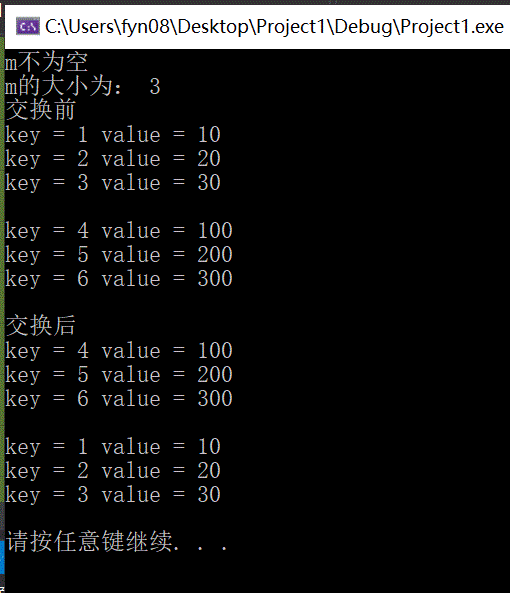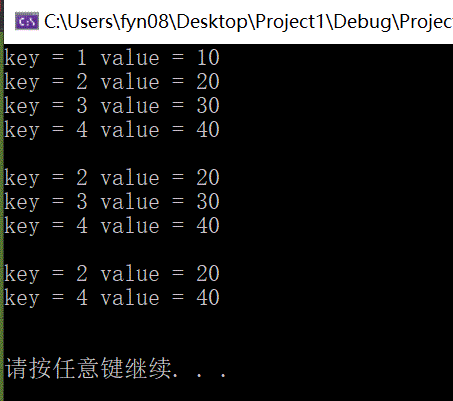1 map基本概念
简介:
- map中所有元素都是pair
- pair中第一个元素为key(键值),起到索引作用,第二个元素为value(实值)
- 所有元素都会根据元素的键值自动排序
本质:
- map/multimap属于关联式容器,底层结构是用二叉树实现。
优点:
- 可以根据key值快速找到value值
map和multimap区别:
- map不允许容器中有重复key值元素
- multimap允许容器中有重复key值元素
2 map构造和赋值
功能描述:
- 对map容器进行构造和赋值操作
函数原型:
构造:
map<T1, T2> mp;//map默认构造函数:map(const map &mp);//拷贝构造函数
赋值:
map& operator=(const map &mp);//重载等号操作符
示例:
#include <map>
void printMap(map<int,int>&m)
{
for (map<int, int>::iterator it = m.begin(); it != m.end(); it++)
{
cout << "key = " << it->first << " value = " << it->second << endl;
}
cout << endl;
}
void test01()
{
map<int,int>m; //默认构造
m.insert(pair<int, int>(1, 10));
m.insert(pair<int, int>(2, 20));
m.insert(pair<int, int>(3, 30));
printMap(m);
map<int, int>m2(m); //拷贝构造
printMap(m2);
map<int, int>m3;
m3 = m2; //赋值
printMap(m3);
}
int main() {
test01();
system("pause");
return 0;
}
打印结果:

总结:map中所有元素都是成对出现,插入数据时候要使用对组
3 map大小和交换
功能描述:
- 统计map容器大小以及交换map容器
函数原型:
size();//返回容器中元素的数目empty();//判断容器是否为空swap(st);//交换两个集合容器
示例:
#include <map>
void printMap(map<int,int>&m)
{
for (map<int, int>::iterator it = m.begin(); it != m.end(); it++)
{
cout << "key = " << it->first << " value = " << it->second << endl;
}
cout << endl;
}
void test01()
{
map<int, int>m;
m.insert(pair<int, int>(1, 10));
m.insert(pair<int, int>(2, 20));
m.insert(pair<int, int>(3, 30));
if (m.empty())
{
cout << "m为空" << endl;
}
else
{
cout << "m不为空" << endl;
cout << "m的大小为: " << m.size() << endl;
}
}
//交换
void test02()
{
map<int, int>m;
m.insert(pair<int, int>(1, 10));
m.insert(pair<int, int>(2, 20));
m.insert(pair<int, int>(3, 30));
map<int, int>m2;
m2.insert(pair<int, int>(4, 100));
m2.insert(pair<int, int>(5, 200));
m2.insert(pair<int, int>(6, 300));
cout << "交换前" << endl;
printMap(m);
printMap(m2);
cout << "交换后" << endl;
m.swap(m2);
printMap(m);
printMap(m2);
}
int main() {
test01();
test02();
system("pause");
return 0;
}
打印结果:

总结:
- 统计大小 --- size
- 判断是否为空 --- empty
- 交换容器 --- swap
4 map插入和删除
功能描述:
- map容器进行插入数据和删除数据
函数原型:
insert(elem);//在容器中插入元素。clear();//清除所有元素erase(pos);//删除pos迭代器所指的元素,返回下一个元素的迭代器。erase(beg, end);//删除区间[beg,end)的所有元素 ,返回下一个元素的迭代器。erase(key);//删除容器中值为key的元素。
示例:
#include <map>
void printMap(map<int,int>&m)
{
for (map<int, int>::iterator it = m.begin(); it != m.end(); it++)
{
cout << "key = " << it->first << " value = " << it->second << endl;
}
cout << endl;
}
void test01()
{
//插入
map<int, int> m;
//第一种插入方式
m.insert(pair<int, int>(1, 10));
//第二种插入方式
m.insert(make_pair(2, 20));
//第三种插入方式
m.insert(map<int, int>::value_type(3, 30));
//第四种插入方式
m[4] = 40;
printMap(m);
//删除
m.erase(m.begin());
printMap(m);
m.erase(3);
printMap(m);
//清空
m.erase(m.begin(),m.end());
m.clear();
printMap(m);
}
int main() {
test01();
system("pause");
return 0;
}
打印结果:

总结:
- map插入方式很多,记住其一即可
- 插入 --- insert
- 删除 --- erase
- 清空 --- clear
5 map查找和统计
功能描述:
- 对map容器进行查找数据以及统计数据
函数原型:
find(key);//查找key是否存在,若存在,返回该键的元素的迭代器;若不存在,返回set.end();count(key);//统计key的元素个数
示例:
#include <map>
//查找和统计
void test01()
{
map<int, int>m;
m.insert(pair<int, int>(1, 10));
m.insert(pair<int, int>(2, 20));
m.insert(pair<int, int>(3, 30));
//查找
map<int, int>::iterator pos = m.find(3);
if (pos != m.end())
{
cout << "找到了元素 key = " << (*pos).first << " value = " << (*pos).second << endl;
}
else
{
cout << "未找到元素" << endl;
}
//统计
int num = m.count(3);
cout << "num = " << num << endl;
}
int main() {
test01();
system("pause");
return 0;
}
打印结果:

总结:
- 查找 --- find (返回的是迭代器)
- 统计 --- count (对于map,结果为0或者1)
6 map容器排序
学习目标:
- map容器默认排序规则为 按照key值进行 从小到大排序,掌握如何改变排序规则
主要技术点:
- 利用仿函数,可以改变排序规则
示例:
#include <map>
class MyCompare {
public:
bool operator()(int v1, int v2) {
return v1 > v2;
}
};
void test01()
{
//默认从小到大排序
//利用仿函数实现从大到小排序
map<int, int, MyCompare> m;
m.insert(make_pair(1, 10));
m.insert(make_pair(2, 20));
m.insert(make_pair(3, 30));
m.insert(make_pair(4, 40));
m.insert(make_pair(5, 50));
for (map<int, int, MyCompare>::iterator it = m.begin(); it != m.end(); it++) {
cout << "key:" << it->first << " value:" << it->second << endl;
}
}
int main() {
test01();
system("pause");
return 0;
}
总结:
- 利用仿函数可以指定map容器的排序规则
- 对于自定义数据类型,map必须要指定排序规则,同set容器